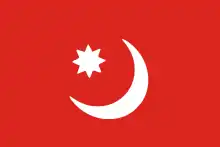Tunganistan
Tunganistan (Chinese: 東干斯坦, Dungan: Хуэситан, 回斯坦, meaning "the homeland of Hui people"), also called Dunganistan (named after the Dungan people), was an independently administered region in the southern part of the Chinese province Xinjiang from 1934 to 1937, contemporaneous to the Chinese Civil War in China proper. The name "Tunganistan" was coined by the Austrian Mongolia expert Walther Heissig. The territory included the oases of the southern Tarim Basin and the centre of the region was Khotan. Tunganistan was surrounded on three sides by troops loyal to Xinjiang governor Sheng Shicai and to the south by the Tibetan Plateau.[2]
Tunganistan/Dunganistan 回斯坦 (Хуэситан) | |
|---|---|
 Alleged flag of Tunganistan[1] | |
| Government | |
• Warlord | Ma Hushan |
| Today part of | |
History
In 1934 (after the First East Turkestan Republic ended), the Muslim Tungan warlord Ma Zhongying vanished into Soviet territory. His successor was Ma Hushan, who fled from Kashgar to Khotan.[3] Ma Hushan regularly received telegrams, ostensibly from his brother-in-law in the USSR, promising the leader of Tunganistan that Ma Zhongying would soon return.[4]
Ma Hushan governed the region from 1934 until 1937, he was called "King" by his subjects. During his rule the Hui Muslims of Inner China governed the territory like a colony with Turkic Muslim subjects.[5] In Tunganistan, taxation was heavy in order to support the needs of the 36th Division of the Chinese National Revolutionary Army. Farmers and merchants were exploited for the benefit of the military garrisons. Forced conscription was common.[6]
In 1935, the troops of Tunganistan crushed the Charkhlik Revolt in the region of present-day Ruoqiang County.
Additionally by 1935, inflation was out of control, homesick Tungan troops were deserting, and Uyghurs frequently fought with Tungan soldiers in the streets of Khotan.[7]
The British writer and adventurer Peter Fleming and the Swiss adventurer Ella Maillart travelled through Tunganistan. Fleming afterwards described in his writings (especially in his book News from Tartary) the region.[8]
In 1937, Soviet troops invaded Tunganistan and incorporated it into the realm of Sheng Shicai's regime. Ma Hushan, who was in mail contact with Chiang Kai-shek, expected some kind of help from the Nationalist government in Nanjing, but he did not receive any help of any kind.[9]
Trivia
- British historian Michael Dillon claimed that the term Dunganistan was meant "humorously".[10]
See also
References

- Autonomous Military Region of Southern Sinkiang : TUNGANISTAN Kingdom, w.ethnia.org (without date).
- Lars-Erik Nyman: Great Britain and Chinese, Russian and Japanese interests in Sinkiang, 1918–1934, Stockholm 1977, p. 122.
- Andrew D. W. Forbes: The Role of the Hui Muslims (Tungans) in Republican Sinkiang, in: Shirin Akiner (ed.): Cultural Change and Continuity in Central Asia, London/New York 2009, pp. 361–372 (here: p. 367).
- Mark Dickens: The Soviets in Xinjiang 1911–1949, academia.edu 1990.
- Andrew D. W. Forbes: Warlords and Muslims in Chinese Central Asia: A Political History of Republican Sinkiang 1911–1949, Cambridge (England) 1986, p. 128.
- Joanne Smith: Four Generations of Uyghurs: The Shift towards Ethno-political Ideologies among Xinjiang's Youth, Inner Asia, Vol. 2 (2000), No. 2, pp. 195–224 (here: p. 204).
- Joanne Smith: Four Generations of Uyghurs: The Shift towards Ethno-political Ideologies among Xinjiang's Youth, Inner Asia, Vol. 2 (2000), No. 2, pp. 195–224 (here: pp. 204/205).
- Anke Kausch: Seidenstraße: Von China durch die Wüsten Gobi und Taklamakan über den Karakorum Highway nach Pakistan, Cologne 2001, p. 271.
- Martin Avery: Bethune's Time: White Men Seeking Grace, (online publication) 2014, p. 88.
- Dillon, Michael (2014). Xinjiang and the Expansion of Chinese Communist Power: Kashgar in the Early Twentieth Century. London. p. 103. ISBN 9781317647201.
His 36th Division was taken over by his half-brother Ma Hushan who led his troops into Khotan and set up a garrison command, from where he controlled a wide area including Khotan itself and the surrounding counties of Yecheng, Bachu, Pishan, Moyu, Yutian, Ruoqiang and Qiemo, sometimes known humorously by Westerners as Dunganistan.
{{cite book}}: CS1 maint: location missing publisher (link)